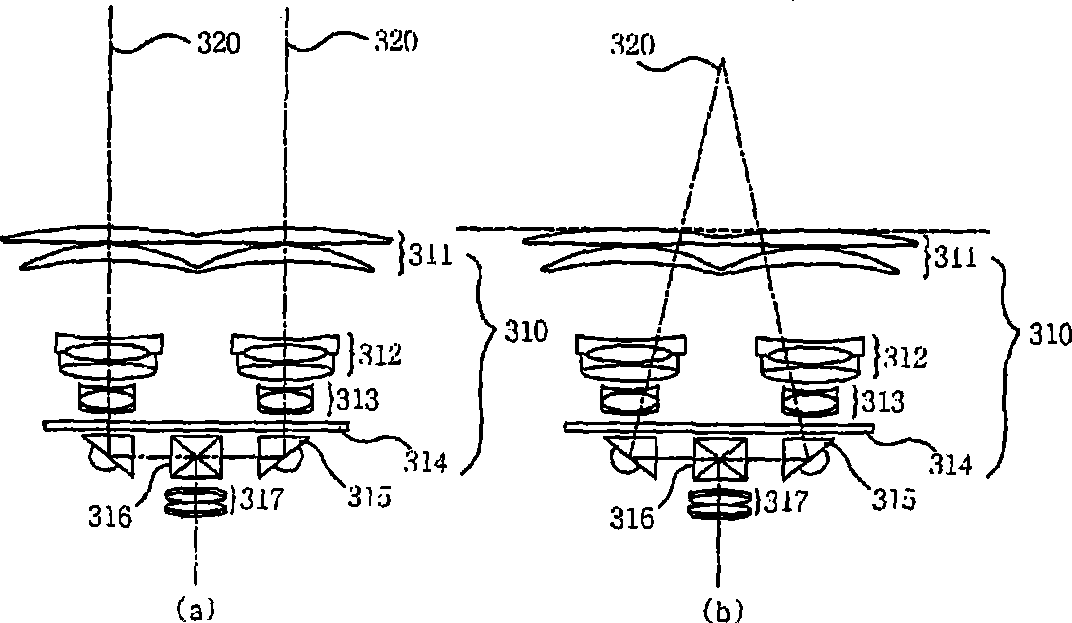3-D photographing lens system
A lens system, three-dimensional camera technology, applied in stereo systems, image communication, instruments, etc., can solve the problems of difficult to maintain equal distances, difficult to operate the zoom lens and focus lens, and difficult to attach, etc. Realize the effect of lens replacement
- Summary
- Abstract
- Description
- Claims
- Application Information
AI Technical Summary
Problems solved by technology
Method used
Image
Examples
no. 1 approach
[0087] Figure 7 A galvanometer provided instead of a rotating disk of a light transmitter / reflector according to a first embodiment of the invention is shown. refer to Figure 7, the two front lenses 410 located on the left and right sides maintain a binocular distance of 65mm and are arranged at the front so that images are formed in the space behind the front lenses 410 . The first relay lens 420 is used to convert the image into parallel light. Simultaneously, an image is synthesized through a galvanometer 433 using total reflection mirrors 431-1 and 431-2, in which two reflection mirrors 433-1 and 433-2 are joined at 50°. Therefore, an image is formed on the CCD 480 via the second relay lens 460 .
[0088] Specifically, for the light reflection operation, in the galvanometer 433 configured such that reflection mirrors 433-1 and 433-2 are formed on both sides at 50°, light initially incident from the left side is captured by the total reflection mirror 431- 1 is reflec...
no. 2 approach
[0092] Figure 8 A galvanometer provided instead of the rotating disk 432 of the light transmitter / reflector 430 according to the second embodiment of the present invention is illustrated. refer to Figure 8 , the two front lenses 410 maintain a binocular distance of 65 mm, and light is incident through the two front lenses 410 to form an image in the space behind the front lenses 410 . The image is transformed into parallel light by the first relay lens 420 . Meanwhile, the total reflection mirrors 431-1 and 431-2 are used, whereby images are synthesized by the galvanometer 434 to which the reflection mirror 434-1 is attached. Therefore, an image is formed on the CCD via the second relay lens 460 .
[0093] Specifically, for the light reflection operation of the galvanometer 434 constituted by the reflection mirror 434-1, light initially incident from the left is reflected by the total reflection mirror 431-1, thereby being deflected by 90° to the right. In this case, if ...
no. 3 approach
[0098] Figure 9 A galvanometer provided instead of the rotating disk 432 of the light transmitter / reflector 430 according to the third embodiment of the present invention is illustrated. refer to Figure 9 , the two front lenses 410 maintain a binocular distance of 65mm, and light is incident through the two front lenses 410 to form an image in the space behind the front lenses 410 . The first relay lens 420 is used to convert the image into parallel light. Meanwhile, the total reflection mirrors 431-1 and 431-2 are used, whereby images are synthesized by the galvanometer 435 to which the reflection mirror 435-1 is attached. Therefore, an image is formed on the CCD via the second relay lens 460 .
[0099] Specifically, for the light reflection operation of the galvanometer 435 constituted by the reflection mirror 435-1, light initially incident from the left is reflected by the total reflection mirror 431-1 and thereby deflected to the right. In this case, if the galvanom...
PUM
 Login to View More
Login to View More Abstract
Description
Claims
Application Information
 Login to View More
Login to View More - R&D Engineer
- R&D Manager
- IP Professional
- Industry Leading Data Capabilities
- Powerful AI technology
- Patent DNA Extraction
Browse by: Latest US Patents, China's latest patents, Technical Efficacy Thesaurus, Application Domain, Technology Topic, Popular Technical Reports.
© 2024 PatSnap. All rights reserved.Legal|Privacy policy|Modern Slavery Act Transparency Statement|Sitemap|About US| Contact US: help@patsnap.com










